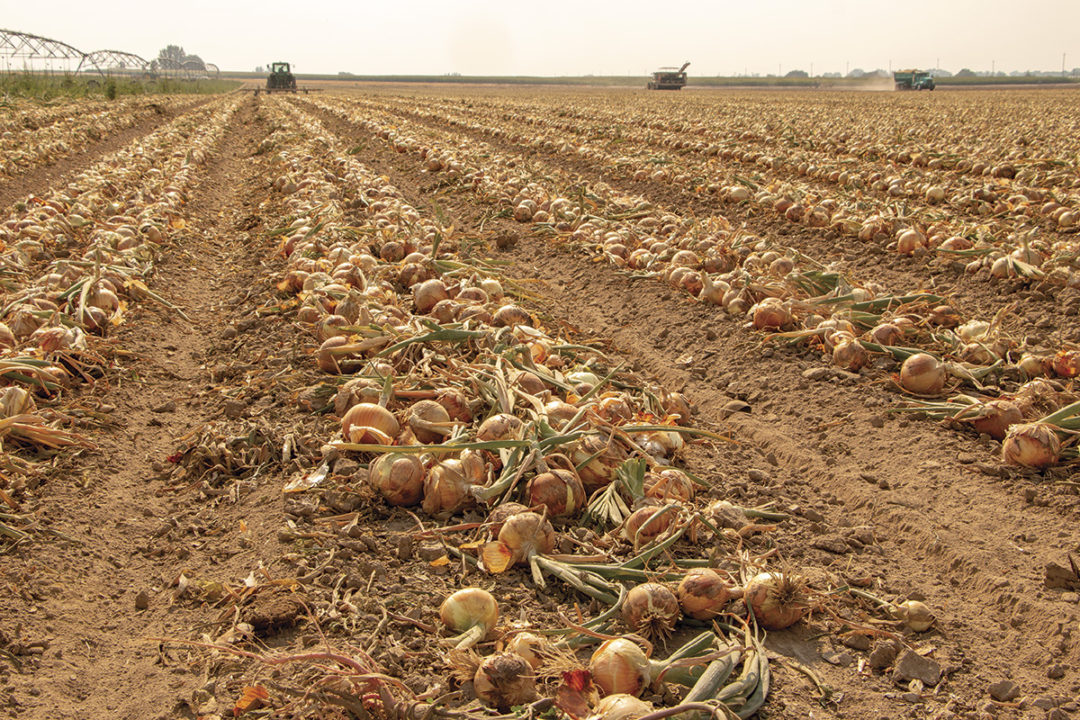“It’s a new year and that’s exciting for everyone, especially coming off a couple hard years,” says Kyler Beck, an agronomist with McCain Foods in Fruitland, specializing in onions. “Not every year will be a hard year.”
In his area, 2022 started with an excellent planting window that quickly turned ugly due to severe wind events. At least one of Beck’s growers reported gusts up to 70 mph. Several suffered stand losses. Unsprouted onions, at just 0.5-inch planting depth, were blown right out of the soil. Sprouted onions suffered sandblasting.
Then too, the Treasure Valley was chilly into June. Cool temperatures, coupled with several cold rains in a row, delayed soil warming: The temperature at 2 inches below soil surface was 6 degrees below average from April to June. “A rainstorm is one of the main drivers of cooling the soil, especially the top few inches,” says Beck, whose background includes soil temperature work at the University of Idaho. Cool air and soil temperatures limited early season crop growth in general, and onions in particular. Some onions lingered at relatively low leaf counts for months, perhaps leaving them more susceptible to hot and dry conditions in July.
“2022, I think, was characterized by variability,” he says. That was spatial as well as temporal. While some producers achieved near-normal production, others had very low yields, onions that failed to make marketable size or that had quality issues.
“Yield was comparable to 2021 in places,” Beck says. And that’s saying something: “2021 was one of the hardest onion crops in a long time,” he says.
Challenges and bright spots across the state
Variability reigned in other areas of the state, as well. Bryan Orr has 39 years as an agronomist behind him and covers a variety of crops from pasture to grains to potatoes in the Rexburg area for Valley Agronomics. “Some didn’t have enough water, and some did,” he says. In particular, well-timed rainstorms helped some producers, while missing others.
Overall, though, he says 2022 was an improvement over 2021 in his area. Moisture was “fairly adequate” and increased crop prices helped somewhat offset rising inputs. And, he says, “We didn’t have much smoke from California, so that was good.”
In between the two, Jacob Patterson is a crop adviser for Simplot Grower Solutions out of Hagerman. He covers a range of crops – grain and silage corn, potatoes, sugarbeets and small grains – in the Magic Valley. “Water was a little tight,” he says, but overall, 2022 production in his area was close to average. Corn may have even beat the average in places.
For all producers, input prices and availability were one of the biggest hurdles to jump last year. “I don’t think anybody knew that closing down the country for as long as we did would have the impact on the supply chain that it has,” Patterson says.
“Usually when prices go up, the first place people cut back is on the fertilizer end,” says Orr. Although he saw some of that in 2022, it was limited. However, effects may yet be seen in 2023, even as prices and availability improve somewhat.
What’s ahead in 2023?
Potatoes are one crop where carryover effects may be seen. Small grains in Orr’s area yielded similar returns to potatoes last year, and the potato price was high last fall. In response, several of his client producers increased their wheat and barley acres at the expense of potatoes.
Further, potato growers were receiving about $25 per hundredweight (cwt) at the processing plant going into 2023. “If seed growers are not getting that, they’re going to sell to processors,” Orr says. This may affect seed availability and cost this spring. “It will all depend on the potato seed market,” he says.
Meanwhile in the Treasure Valley, the onion crop may experience a different type of carryover effect. “I haven’t heard anything to make me think [onion acres] would be reduced from last year,” Beck says. Rather, he suggests keeping an eye on the irrigation systems. Over 75% of the onions in his area are now under drip irrigation to help conserve water and reduce nitrate leaching. However, the annual expenses are high for new drip tape and station upkeep.
“I do expect some growers – a small percentage – not to utilize all the drip stations that they have,” he says. Running low on liquid assets following two hard years and having not seen benefits to drip irrigation in those years, some feel that these systems are not worth the money. The comfort of reverting to furrow irrigation (a more familiar practice) may also play a role.
Then, too, they may hope to make their onions more resistant to damage from another high-heat event. “Drip irrigation doesn’t wet the soil as much as furrow irrigation,” Beck says. He has a hunch that higher evaporative cooling in furrow-irrigated fields may benefit the plants in extremely hot, dry summers like that of 2021.
But drip irrigation systems improve crop yield and quality in normal years. Onions benefit from consistent soil moisture and can develop double centers if subjected to even small amounts of water stress. If farmers switch back to other irrigation methods, these factors may suffer along with water efficiency.
'Keep on doing what we’re doing'
Overall, though, farmers across the state are rising to the challenge. “Most of my growers down here are optimistic,” Patterson says. “Water is looking pretty good right now, although that can change if we don’t get more snow.” Worldwide wheat production is down, and commodity prices are still strong. Product availability is looking better for the new year, and input costs are slightly down.
“Last year was a crazy year, but every year I think, ‘that was a crazy year,’” Patterson laughs. “We’ll just keep on doing what we’re doing and making the most of the ground we’ve got.”



.jpg?height=auto&t=1713304395&width=285)


